

BASH (Unix/Linux) Bourne shell. The Bourne shell was the default Unix shell of Unix Version 7.
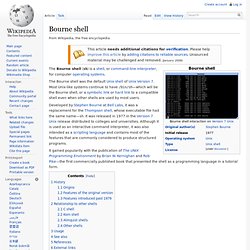
Most Unix-like systems continue to have /bin/sh—which will be the Bourne shell, or a symbolic link or hard link to a compatible shell even when other shells are used by most users. Developed by Stephen Bourne at Bell Labs, it was a replacement for the Thompson shell, whose executable file had the same name—sh. It was released in 1977 in the Version 7 Unix release distributed to colleges and universities. Although it is used as an interactive command interpreter, it was also intended as a scripting language and contains most of the features that are commonly considered to produce structured programs. It gained popularity with the publication of The UNIX Programming Environment by Brian W. BusyBox. History[edit] Origins[edit] BusyBox was maintained by Enrique Zanardi and focused on the needs of the Debian boot-floppies installer system until early 1998, when Dave Cinege took it over for the Linux Router Project (LRP).
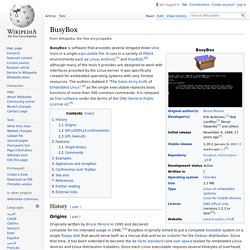
Cinege made several additions, created a modularized build environment, and shifted BusyBox's focus into general high-level embedded systems. As LRP development slowed down in 1999, Erik Andersen, then of Lineo, Inc., took over the project and became the official maintainer between December 1999 and March 2006. During this time the Linux embedded marketplace exploded in growth, and BusyBox matured greatly, expanding both its user base and functionality.
GPLv2/GPLv3 controversies[edit] As of October 2006[update] Denys Vlasenko took over maintainership of BusyBox from Rob Landley, who started Toybox, also as result of the license controversies.[12][15] GPL lawsuits[edit] Features[edit] BusyBox can be customized to provide a subset of over two hundred utilities. /bin/ls. Z shell. Origin[edit] The first version of zsh was written by Paul Falstad in 1990[2] when he was a student at Princeton University.[3] The name zsh derives from Yale professor Zhong Shao's (then a teaching assistant at Princeton University) name — Paul Falstad thought that Shao's login name, "zsh", was a good name for a shell.[4][5] The American English pronunciation of Z is "zee", so Z shell rhymes with C shell, which is a homophone of seashell.

Features[edit] Z shell's configuration utility for new users Features of note include: Attesting to the sheer size of this shell is the famous first sentence of the shell's manual page, which reads "Because zsh contains many features, the zsh manual has been split into a number of sections" and then goes on to list seventeen items.[7] See also[edit] References[edit] ^ Jump up to: a b "The Z Shell Manual" (Version 5.0.0).
Korn shell. Design[edit] KornShell complies with POSIX.2, Shell and Utilities, Command Interpreter (IEEE Std 1003.2-1992.)
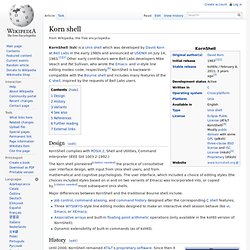
The Korn shell pioneered[citation needed] the practice of consultative user interface design, with input from Unix shell users, and from mathematical and cognitive psychologists. The user interface, which included a choice of editing styles (the choices included styles based on vi and on two variants of Emacs) was incorporated into, or copied by,[citation needed] most subsequent Unix shells. Major differences between KornShell and the traditional Bourne shell include: History[edit] Interaction with pdksh in OpenBSD (default shell) The functionality of the original KornShell, ksh88, was used as a basis for the standard POSIX.2, Shell and Utilities, Command Interpreter (IEEE Std 1003.2-1992.) Some vendors still ship their own version of the older ksh88, sometimes with extensions. ksh93 is still maintained by its author. UnixWare 7 includes both ksh88 and ksh93. NetBSD. NetBSD is an open-source, Unix-like operating system that descends from Berkeley Software Distribution (BSD), a Unix derivative developed at the University of California, Berkeley.
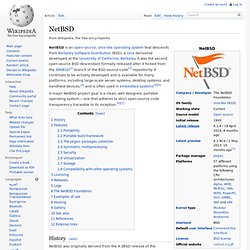
It was the second open-source BSD descendant formally released after it forked from the 386BSD[2] branch of the BSD source-code[3] repositority. It continues to be actively developed and is available for many platforms, including large-scale server systems, desktop systems, and handheld devices,[3] and is often used in embedded systems[4][5] A major NetBSD project goal is a clean, well designed, portable operating system— one that adheres to strict open-source code transparency traceable to its inception.[6][7] History[edit] Until 2004, NetBSD 1.x releases were made at roughly annual intervals, with minor "patch" releases in between. Unix shell. Tcsh and sh shell windows on a Mac OS X desktop.
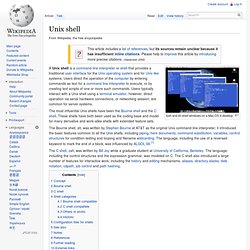
The most influential Unix shells have been the Bourne shell and the C shell, These shells have both been used as the coding base and model for many derivative and work-alike shells with extended feature sets. The C shell, csh, was written by Bill Joy while a graduate student at University of California, Berkeley. The language, including the control structures and the expression grammar, was modeled on C. Linux/unix (Bourne shell compatible)